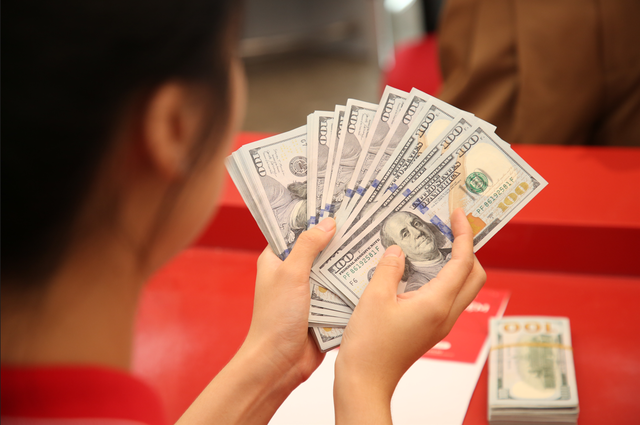
Specifically at Vietcombank, the USD is being quoted at 24,570-24,910 dong, up 40 dong from yesterday. This is the highest quoted level at Vietcombank to date.
USD rates at many other banks are also nearing 24,900 dong. Among them, Techcombank increased by about 40 dong this morning to 24,565-24,908 dong. At ACB, the USD exchange rate in cash form is quoted at 24,540-24,940 dong, while the transfer form is 24,590-24,890 dong. BIDV applies 24,580-24,890 dong, up 35 dong from yesterday.
USD rates on the free market today also change direction and increase sharply after continuous cooling in previous sessions. Currently, the popular buying rate is 25,500 dong and the selling rate is about 25,550 dong, up about 100-120 dong from yesterday. Previously, the USD rate on the free market reached a peak of 25,700 dong at the end of last week.
In the international market, the DXY index, which measures the strength of the greenback against major currencies, rebounded strongly from 102.7 to 103.5 points.
The central exchange rate announced by the State Bank on March 15 is 23,979 dong/USD. With the amplitude of +/- 5%, the floor rate and ceiling rate applicable to commercial banks are 22,781-25,177 dong.
In relation to recent hot developments in exchange rates, the State Bank has taken action to cool down the exchange rate by resuming the issuance of bills from March 11 onwards.
After 4 sessions from March 11-14, the SBV has issued nearly 60,000 trillion dong in bills, thus withdrawing the corresponding amount of money from the system. Analysts believe that by withdrawing VND, VND interest rates in interbank will increase and narrow the difference with USD interest rates, thereby limiting speculation in USD on the market.
In a recent analysis report, BSC Securities Company said that SBV bills are short-term papers issued by the SBV to implement the national monetary policy. Entities participating in the purchase and sale of bills include the SBV and credit institutions with VNĐ payment accounts at the SBV. The short-term goal when the SBV issues bills is to regulate liquidity in the market in the short term to impact the exchange rate. In the long term, issuing bills to stabilize the exchange rate, interest rates, liquidity,… to serve the long-term goals of the monetary policy.
Looking back at the most recent bill issuance period from September 21 to November 8, 2023, the SBV withdrew a net of 194,649 trillion dong during this period. The money withdrawal took place when the USD/VND exchange rate increased sharply (up 3.48% from the beginning of the third quarter to September 21, 2023). Also in this period, system liquidity was surplus with interbank rates from July 2023 at low levels below 1%.
After the SBV withdrew money, the exchange rate started to decrease and maintained downward momentum until the end of November 2023. Overnight interbank interest rates increased by more than 2% during the period from September 21 to October 25, 2023 – in response to the money withdrawal measure, but then quickly decreased again.
For the bill issuance period starting from March 11, 2024, BSC believes that the reason for the SBV’s return to using the bill tool is to support the exchange rate when it has recently increased sharply due to: (1) the interest rate differential between the VND and the USD; (2) the DXY-Index increased (but still at a low level of 102.8); (3) the Fed signaled a delay in interest rate cuts from the first quarter to the second quarter of 2024. BSC also forecasts that the net withdrawal scale during this period could be around 100,000-150,000 trillion dong. The average bill interest rate is about 1-1.3%/year.



































